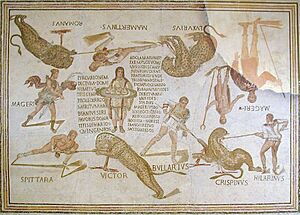Magerius Mosaic facts for kids
The Magerius Mosaic is an amazing ancient artwork from the 3rd century. It's a type of art called a Roman mosaic. It was found in 1966 in a village in Tunisia called Smirat. Today, you can see it at the Sousse Archaeological Museum. We think this mosaic decorated a large country home, or Roman villa, owned by a man named Magerius.
Contents
What the Magerius Mosaic Shows
This mosaic shows an exciting scene: a wild animal hunt! You can see four hunters, each with their own name, fighting four leopards, who also have names.
The Hunt and the Money
Right in the middle of the mosaic, there's a person called a steward. This steward is holding a tray with four bags of money on it. Each moneybag stands for one thousand denarii, which was a type of Roman coin. This part of the mosaic is very special because it gives us a rare clue about how much money was paid for animals used in big shows. These shows often took place in amphitheatres.
Gods and Goddesses in the Mosaic
Besides the hunters and the steward, there are two other important figures in the mosaic. Even though there's a Latin writing nearby that says Mageri, these figures are thought to be Roman gods or goddesses.
- On the left side, you can see a figure walking forward. This is usually believed to be Diana, the Roman goddess of the hunt.
- Another figure holds a saucer-shaped object in one hand and a staff in the other. This figure is often identified as Bacchus or Liber Pater, who were Roman gods of wine and freedom.
Animal Shows in Roman Villas
During Roman times, it was common for wealthy people to have mosaics in their villas that showed venatio shows. These were special events where hunters fought wild animals in an amphitheatre. The Magerius Mosaic is a great example of this kind of art.


